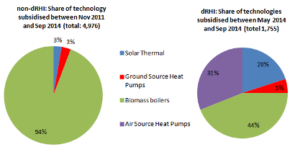UK Energy Minister Greg Barker, initiator of The Green Deal, called it a “flagship energy efficiency programme” during the launch of the scheme in the beginning 2013. One and half years later Barker stepped down as minister and the statistics of the Green Deal shows a rather poor performance despite more than half-a-billion pounds of taxpayers’ money being spent. The question is now whether the whole scheme can survive after the parliament members of the Energy and Climate Change Select Committee report delivered a highly critical review of the programme’s performance and describes how “the first eighteen months of the Green Deal have been largely wasted”.
Banner: Department of Energy and Climate Change (DECC)
The Green Deal was intended to tackle the key barriers to the take-up of energy efficiency measures in buildings. This included a wide variety of technologies and measures such as solar water heating, transpired solar collectors, heat pumps, photovoltaics and biomass boilers. In fact, this list grew further to over 45 measures which included glazing, high efficiency boilers, heat recovery, insulation and heating controls.
The Green Deal concept is based on a loan offer, whose repayments are attached to the utility bill at a property, rather than to an individual. This would then pass to any new occupier or bill payer in the event of a transfer of the property. The “Golden Rule” was that the instalment payments should never exceed the savings on an average utility bill. So it would feel like the energy-saving measures were not costing anything even though really they were. Actually this rule is based an estimate of future energy costs and this could become a problem as the household’s energy savings may not have covered the cost of scheme’s interest rates of often 6 to 8 %.
350,000 Green Deal Assessments leads to only 6,000 approved finance plans
The energy minister responsible at the time, Greg Barker, said that he “would not be sleeping” if 10,000 Green Deal plans had not been signed by the end of 2013. By end of February 2014, it became clear he had got his forecast spectacularly wrong as the total by then was just 1,754. The minister then resigned but by September 2014, approaching 6,000 Green Deal finance plans had been agreed. However only 4 of these were for solar water heating systems compared with 1,597 for photovoltaics (see following table). This is a small number compared to over 350,000 Green Deal Assessments that were done by September 2014.
| Administration level |
Demand in the first 18 months of the Green Deal Scheme |
| 4,000 Green Deal Assessors belonging to around 400 assessor organisations |
Over 350,000 Green Deal Assessments |
| 160 Green Deal Providers sign Green Deal Plans with the customers over recommended measures |
6,000 agreed finance plans of which 4 for solar water heating systems and 1,597 for photovoltaics |
Looking at the statistics of the first 18 months there is no doubt that The Green Deal has been a poor deal for solar thermal.
Source: Department of Energy and Climate Change (DECC)
During late 2013, further announcements were made to help the scheme. There was the Green Deal ‘Cash-back’ that acted more like a grant although this aspect was not available for the renewable energy measures. In mid-2014, there was a further form of grant called the ‘Home Improvement Fund’ however this was stopped almost overnight as suddenly it became too popular. This created many complaints as householders were already out of pocket from having taken the initial assessment which they paid up front. Although The Green Deal was meant to be basically a loan, in fact you could still access these ‘grant’ aspects as long as the applicant had their own savings. So it was like there was really no loan needed after all.
High spending because of many administrative layers
Behind the simple name and idea of The Green Deal, there were actually many administrative layers. Customers first required a Green Deal Assessment (GDA) for a fee of approximately GBP 120 which provided a report. There are about 4,000 Green Deal assessors to choose from and these in turn belong to one of around 400 assessor organisations. The assessor recommends improvements that are appropriate for the property and indicates whether they meet the “Golden Rule”.
One of over 160 Green Deal providers would then quote for the recommended improvements with the funding. The Green Deal Plan is a contract between customer and the Green Deal provider which sets out the work that will be done and the repayments including the fixed interest rate. Then finally there are one of over 2,700 installer companies available to fit the agreed measures who have to be accredited. For the finance, there was a not-for-profit Green Deal Finance Company (TGDFC) that has over 50 members including representatives from the banks and utilities.
And even further behind the scenes, there are at least another seven organisations listed in the administration to create The Green Deal. The problem with so many layers is that all these people want their fees. So then the customers found they could get an ordinary loan direct from a bank for much less interest rate. So without engaging the Green Deal Plan, they could still use the suggestions of the GDA but with much less administration. Also the high administration meant only the large renewable system suppliers want to become involved at each level. This made it difficult for the small solar thermal installation companies to recommend The Green Deal to their customers. Another problem for the small solar thermal players was the lack of independence rules between each administrative layer. So in fact assessors could easily also work for a particular installation company and yet have a vested interest to prefer particular measures.
More information:



